Glass Fiber Market Size
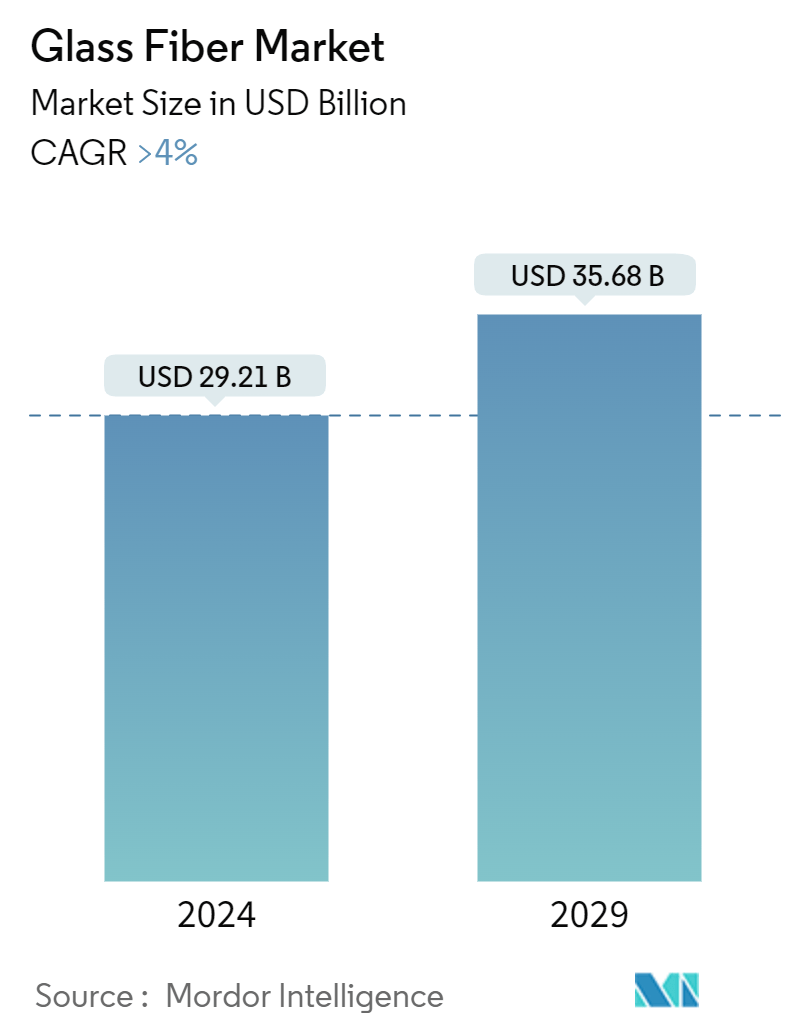
| Study Period | 2019 - 2029 |
| Market Size (2024) | USD 29.21 Billion |
| Market Size (2029) | USD 35.68 Billion |
| CAGR (2024 - 2029) | 4.00 % |
| Fastest Growing Market | Asia Pacific |
| Largest Market | Asia Pacific |
Major Players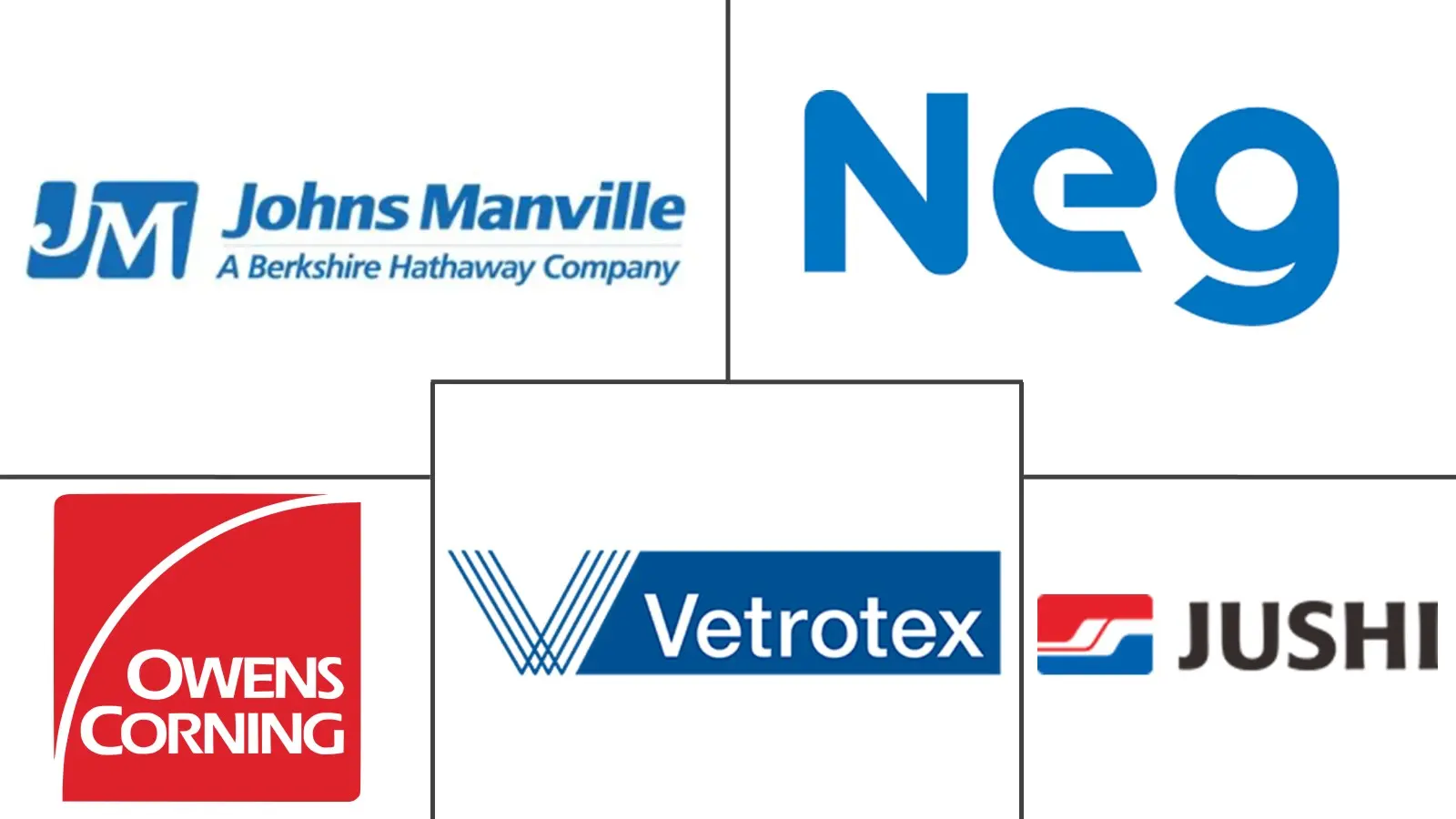
*Disclaimer: Major Players sorted in no particular order |
Glass Fiber Market Analysis
The Glass Fiber Market size is estimated at USD 29.21 billion in 2024, and is expected to reach USD 35.68 billion by 2029, growing at a CAGR of greater than 4% during the forecast period (2024-2029).
- The significant factors expected to drive the glass fiber market are the increasing demand from the construction industry and the rising demand for fiberglass composites from the automotive industry.
- However, the low-profit margin on sales and competition from carbon fiber and rock wool are likely to restrain the growth of the glass fiber market in the upcoming period.
- The increase in the use of lightweight glass fiber-reinforced plastic (GFRP) composites and the increase in the demand for composite materials from the wind energy sector are opportunities for the market to be studied in the upcoming period.
- Asia-Pacific is likely to dominate the glass fiber market.
Glass Fiber Market Trends
Rising Demand from the Building and Construction Sector
- Glass fiber is an eco-friendly construction material. It is available in the form of glass-fiber reinforced concrete (GRC). Without causing weight and environmental damage, the GRC provides buildings with a solid appearance.
- The use of glass fibers in the cement mix strengthens the material with corrosion-resistant strong fibers, which makes GRC long-lasting for any construction requirement. The construction of walls, foundations, panels, and facades will be made much easier and quicker because of GRC's low weight.
- One of the world's largest construction industries is based in the United States. According to the United States Census Bureau, construction spending in February 2024 grew by 10.7% from February 2023 estimate. In addition, construction spending in the first two months of 2024 was up 11.9% from 2023, thus highlighting the gradual improvement in construction spending in the United States.
- Eurostat stated that building construction increased by 1.9% in the Euro area and 2.4% in the European Union in December 2023 compared to December 2022.
- Thus, due to this growth in the building and construction sector, the demand for glass fiber will increase during the forecast period.
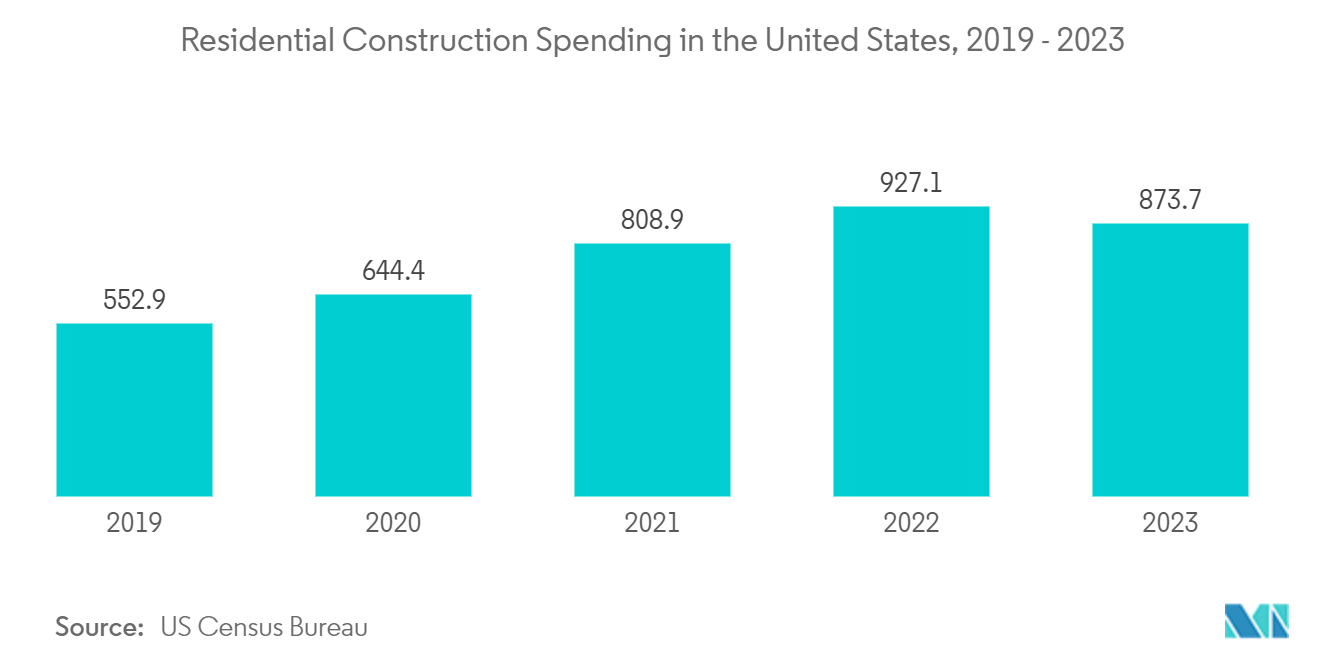
Asia-Pacific to Dominate the Market
- The Asia-Pacific region, particularly countries like China, India, and Japan, has been experiencing rapid industrialization and urbanization. This has increased demand for construction materials, automotive components, and infrastructure development, driving the demand for glass fiber.
- The construction industry in the Asia-Pacific region is booming and fueled by urbanization, population growth, and infrastructure development initiatives. Glass fibers are widely used in construction materials such as reinforced concrete, insulation, and composite panels, driving their demand in the region.
- The construction sector in China is increasing rapidly. The country has the most significant building market globally, making up 20% of all construction investment worldwide. The 14th Five-Year Plan of China is focused on new infrastructure projects for transport, energy, water, and urban development. According to the International Trade Administration, approximately USD 27 trillion will be spent on new infrastructure in China during the 14th Five-Year Plan between 2021 and 2025, with an estimated value of EUR 4.2 trillion.
- The Indian budget for infrastructure has been set at USD 1.4 trillion, according to the National Investment Promotion and Facilitation Agency's data.
- The Asia-Pacific region is the world's largest automotive manufacturing hub, accounting for almost 60% of global production. China and India are significant vehicle manufacturers within Asia-Pacific. According to OICA, China, with a total vehicle production of 30.16 million units in 2023, an increase of 16% compared to 27.02 million units produced last year, has the most significant automotive production base in the world, according to the China Automobile Manufacturers' Association.
- Overall, continuous investments in various end-user sectors are likely to boost the consumption of glass fiber in Asia-Pacific.
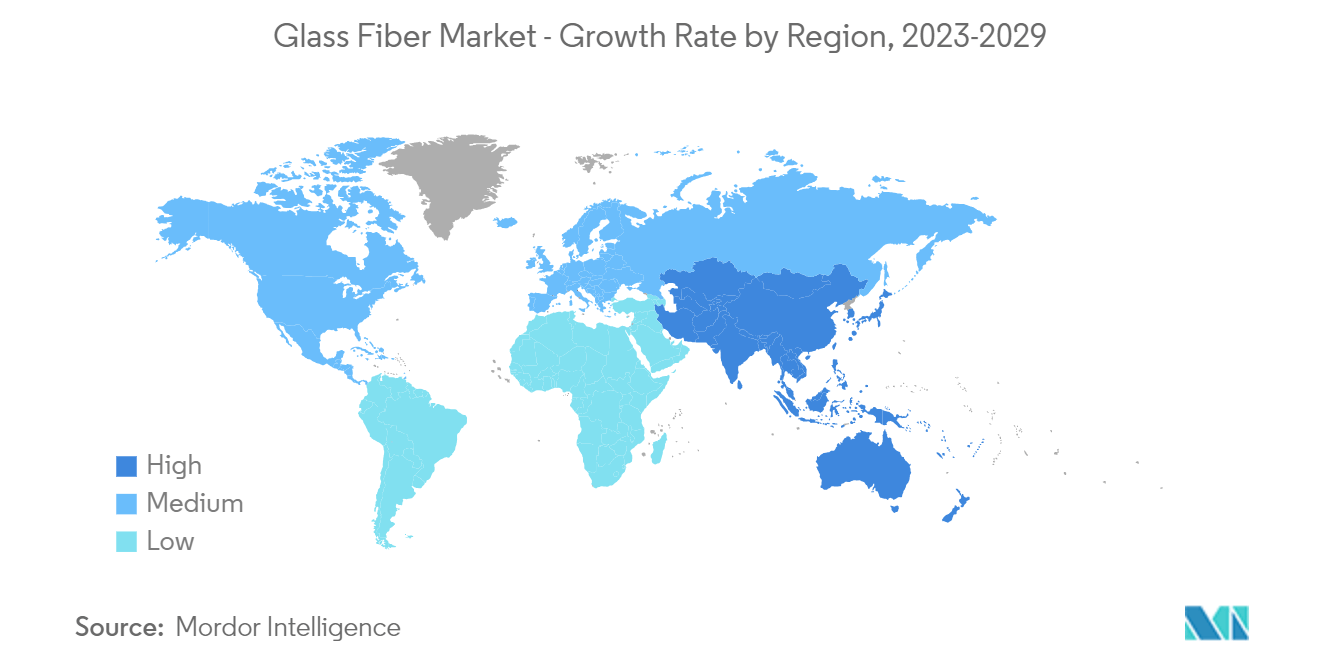
Glass Fiber Industry Overview
The glass fiber market is consolidated. The major players (not in any particular order) include Owens Corning, Saint-Gobain Vetrotex, Johns Manville, Nippon Electric Glass Co. Ltd, and China Jushi Co. Ltd.
Glass Fiber Market Leaders
-
Owens Corning
-
Saint-Gobain Vetrotex
-
Johns Manville
-
Nippon Electric Glass Co., Ltd.
-
China Jushi Co., Ltd.
*Disclaimer: Major Players sorted in no particular order
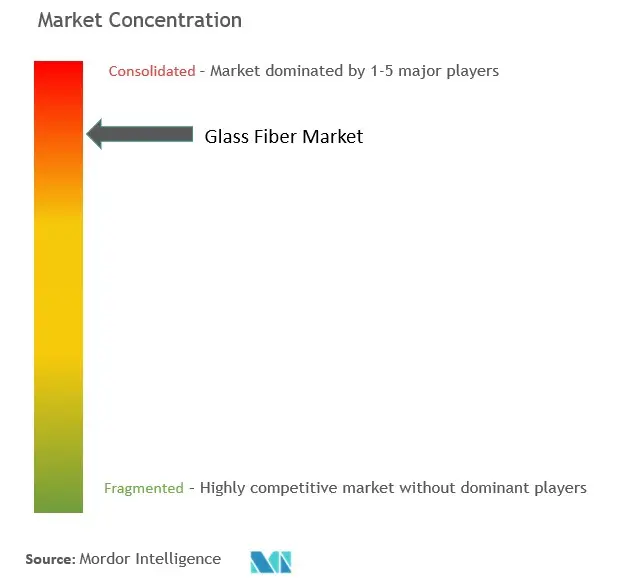
Glass Fiber Market News
- October 2023: Ahlstrom (a manufacturer of fiber-based materials) introduced its new glass fiber tissue line for high-performance building materials. As the market shifts toward sustainable, high-performance building materials, Ahlstrom continues expanding its glass fiber tissue businesses and strengthening its manufacturing operations worldwide with the completion of a significant investment at its manufacturing facility in Madisonville, Kentucky, the United States.
- August 2022: Owens Corning and Pultron Composites collaborated to manufacture fiberglass rebar. The joint venture between the companies will provide them with more sustainable product solutions. Thus, the companies launched PINKBAR Fiberglas Rebar, used in flatwork and residential applications, and MATEENBAR Fiberglas Rebar, used in heavy-load structural applications in newer markets.
- February 2022: China Jushi Co. Ltd terminated India's 100,000-ton-per-year alkali-free glass fiber pool kiln wire drawing production line. The company also announced that it would start a new fiberglass manufacturing facility in Egypt. The production capacity of this new plant is expected to be 120,000 tons per annum.
Glass Fiber Market Report - Table of Contents
1. INTRODUCTION
- 1.1 Study Assumptions
- 1.2 Scope of the Study
2. RESEARCH METHODOLOGY
3. EXECUTIVE SUMMARY
4. MARKET DYNAMICS
-
4.1 Drivers
- 4.1.1 Increasing Demand from the Construction Industry
- 4.1.2 Increasing Demand for Fiberglass Composites from the Automotive Industry
-
4.2 Restraints
- 4.2.1 Competition from Carbon Fiber and Rockwool
- 4.2.2 Low Profit Margin on Sales
- 4.3 Industry Value Chain Analysis
-
4.4 Porter's Five Forces Analysis
- 4.4.1 Bargaining Power of Suppliers
- 4.4.2 Bargaining Power of Consumers
- 4.4.3 Threat of New Entrants
- 4.4.4 Threat of Substitute Products and Services
- 4.4.5 Degree of Competition
5. MARKET SEGMENTATION (Market Size in Value)
-
5.1 Resin Type
- 5.1.1 Chopped Strands
- 5.1.2 Glass Wool
- 5.1.3 Roving
- 5.1.4 Yarn
-
5.2 Application
- 5.2.1 Composites
- 5.2.2 Insulation
-
5.3 End-user Industry
- 5.3.1 Buildings and Construction
- 5.3.2 Automotive
- 5.3.3 Aerospace and Defense
- 5.3.4 Alternative Energy
- 5.3.5 Consumer Goods
- 5.3.6 Industrial
- 5.3.7 Other End-user Industries (Electronics)
-
5.4 Geography
- 5.4.1 Asia-Pacific
- 5.4.1.1 China
- 5.4.1.2 India
- 5.4.1.3 Japan
- 5.4.1.4 South Korea
- 5.4.1.5 Malaysia
- 5.4.1.6 Thailand
- 5.4.1.7 Indonesia
- 5.4.1.8 Vietnam
- 5.4.1.9 Rest of Asia-Pacific
- 5.4.2 North America
- 5.4.2.1 United States
- 5.4.2.2 Canada
- 5.4.2.3 Mexico
- 5.4.3 Europe
- 5.4.3.1 Germany
- 5.4.3.2 France
- 5.4.3.3 United Kingdom
- 5.4.3.4 Italy
- 5.4.3.5 Spain
- 5.4.3.6 Turkey
- 5.4.3.7 Russia
- 5.4.3.8 NORDIC
- 5.4.3.9 Rest of Europe
- 5.4.4 South America
- 5.4.4.1 Brazil
- 5.4.4.2 Argentina
- 5.4.4.3 Colombia
- 5.4.4.4 Rest of South America
- 5.4.5 Middle East and Africa
- 5.4.5.1 Saudi Arabia
- 5.4.5.2 South Africa
- 5.4.5.3 Nigeria
- 5.4.5.4 Qatar
- 5.4.5.5 Egypt
- 5.4.5.6 UAE
- 5.4.5.7 Rest of Middle East and Africa
6. COMPETITIVE LANDSCAPE
- 6.1 Mergers and Acquisitions, Joint Ventures, Collaborations, and Agreements
- 6.2 Market Share (%)**/ Ranking Analysis
- 6.3 Strategies Adopted by Leading Players
-
6.4 Company Profiles
- 6.4.1 ASAHI FIBER GLASS Co. Ltd
- 6.4.2 Binani Industries Ltd
- 6.4.3 China Jushi Co. Ltd
- 6.4.4 Chongqing Polycomp International Corp. (CPIC)
- 6.4.5 CTG Group
- 6.4.6 Heraeus Holding
- 6.4.7 Johns Manville
- 6.4.8 Nippon Electric Glass Co. Ltd
- 6.4.9 Owens Corning
- 6.4.10 PFG FIBER GLASS CORPORATION
- 6.4.11 Saint-Gobain Vetrotex
- 6.4.12 TAIWAN GLASS IND. CORP.
- *List Not Exhaustive
7. MARKET OPPORTUNITIES AND FUTURE TRENDS
- 7.1 Growth in the Usage of Lightweight Glass Fiber Reinforced Plastic (GFRP) Composites
- 7.2 Increasing Demand for Fiberglass Composite Materials for the Wind Energy Sector
Glass Fiber Industry Segmentation
Glass fiber, also known as fiberglass, is a material composed of extremely fine glass fibers. These fibers can be woven into a fabric or used as a reinforcing material in composite materials. Glass fibers are known for their high strength, lightweight, and corrosion resistance properties, making them suitable for a wide range of applications across industries such as construction, automotive, aerospace, marine, electronics, and telecommunications. They are commonly used in insulation, composites, reinforcement materials, and optical fibers.
The glass fiber market is segmented by type, application, end-user industry, and geography. On the basis of type, the market is segmented into chopped strands, glass wool, roving, and yarn. On the basis of application, the market is segmented into composites and insulation. On the basis of the end-user industry, the market is segmented into building and construction, automotive, aerospace and defense, alternative energy, consumer goods, industrial, and other end-user industries (electronics). The report also covers the market size and forecasts for the glass fiber market in 15 countries across major regions. For each segment, the market sizing and forecast have been done on the basis of value (USD).
| Resin Type | Chopped Strands | |
| Glass Wool | ||
| Roving | ||
| Yarn | ||
| Application | Composites | |
| Insulation | ||
| End-user Industry | Buildings and Construction | |
| Automotive | ||
| Aerospace and Defense | ||
| Alternative Energy | ||
| Consumer Goods | ||
| Industrial | ||
| Other End-user Industries (Electronics) | ||
| Geography | Asia-Pacific | China |
| India | ||
| Japan | ||
| South Korea | ||
| Malaysia | ||
| Thailand | ||
| Indonesia | ||
| Vietnam | ||
| Rest of Asia-Pacific | ||
| Geography | North America | United States |
| Canada | ||
| Mexico | ||
| Geography | Europe | Germany |
| France | ||
| United Kingdom | ||
| Italy | ||
| Spain | ||
| Turkey | ||
| Russia | ||
| NORDIC | ||
| Rest of Europe | ||
| Geography | South America | Brazil |
| Argentina | ||
| Colombia | ||
| Rest of South America | ||
| Geography | Middle East and Africa | Saudi Arabia |
| South Africa | ||
| Nigeria | ||
| Qatar | ||
| Egypt | ||
| UAE | ||
| Rest of Middle East and Africa |
Glass Fiber Market Research FAQs
How big is the Glass Fiber Market?
The Glass Fiber Market size is expected to reach USD 29.21 billion in 2024 and grow at a CAGR of greater than 4% to reach USD 35.68 billion by 2029.
What is the current Glass Fiber Market size?
In 2024, the Glass Fiber Market size is expected to reach USD 29.21 billion.
Who are the key players in Glass Fiber Market?
Owens Corning, Saint-Gobain Vetrotex, Johns Manville, Nippon Electric Glass Co., Ltd. and China Jushi Co., Ltd. are the major companies operating in the Glass Fiber Market.
Which is the fastest growing region in Glass Fiber Market?
Asia Pacific is estimated to grow at the highest CAGR over the forecast period (2024-2029).
Which region has the biggest share in Glass Fiber Market?
In 2024, the Asia Pacific accounts for the largest market share in Glass Fiber Market.
What years does this Glass Fiber Market cover, and what was the market size in 2023?
In 2023, the Glass Fiber Market size was estimated at USD 28.04 billion. The report covers the Glass Fiber Market historical market size for years: 2019, 2020, 2021, 2022 and 2023. The report also forecasts the Glass Fiber Market size for years: 2024, 2025, 2026, 2027, 2028 and 2029.
What's driving the Glass Fiber Market growth?
The major factor driving the growth of the market is the increasing demand for fiberglass composites from the automotive industry.
What are the key challenges in the Glass Fiber Market?
The key challenges in the Glass Fiber Market are: a) Fluctuations in the costs of raw materials b) High competition from carbon fiber and Rockwool
What's driving the Glass Fiber Market growth?
The major factor driving the growth of the market is the increasing demand for fiberglass composites from the automotive industry.
Glass Fiber Industry Report
The hybrid vehicle market is experiencing significant growth, driven by increasing environmental awareness and government incentives for cleaner transportation solutions. Hybrid vehicles, which combine electric motors and internal combustion engines, offer better fuel efficiency and lower emissions compared to conventional vehicles. The market is segmented into passenger cars and commercial vehicles, with passenger cars holding the largest hybrid vehicle market share due to their suitability for stop-and-go driving. Additionally, the market is categorized by electric powertrain types, with parallel hybrids leading due to their cost-effectiveness and efficiency. The degree of hybridization also plays a role, with full hybrids dominating the market due to their flexible operation and fuel economy.
Regional analysis shows that Asia Pacific is a key player, driven by government initiatives and increasing adoption of hybrid vehicles in countries like China and India. Hybrid car manufacturers are focusing on expanding their product lines and investing in research and development to meet the growing demand for hybrid vehicles. Statistics for the hybrid vehicle market share, market size, and revenue growth rate are provided by Mordor Intelligence™ Industry Reports. Hybrid vehicle analysis includes a market forecast outlook and historical overview. Get a sample of this industry analysis as a free report PDF download.
The industry analysis highlights the market growth and market trends within the global market. The industry information provided includes market data and market segmentation, which are crucial for understanding the market value and market outlook. The market forecast offers insights into the future market predictions and market review. The industry reports and industry research underline the importance of industry statistics and industry trends, which guide the market leaders in their strategic decisions. The market overview encapsulates the current state of the market, while the industry outlook and industry size provide a broader perspective on the hybrid vehicle market.
Research companies are continuously updating their industry sales reports to reflect the latest market dynamics. The report example and report PDF serve as valuable resources for stakeholders looking for detailed market analysis. The combination of industry trends, market data, and market growth ensures a comprehensive understanding of the hybrid vehicle market landscape.



